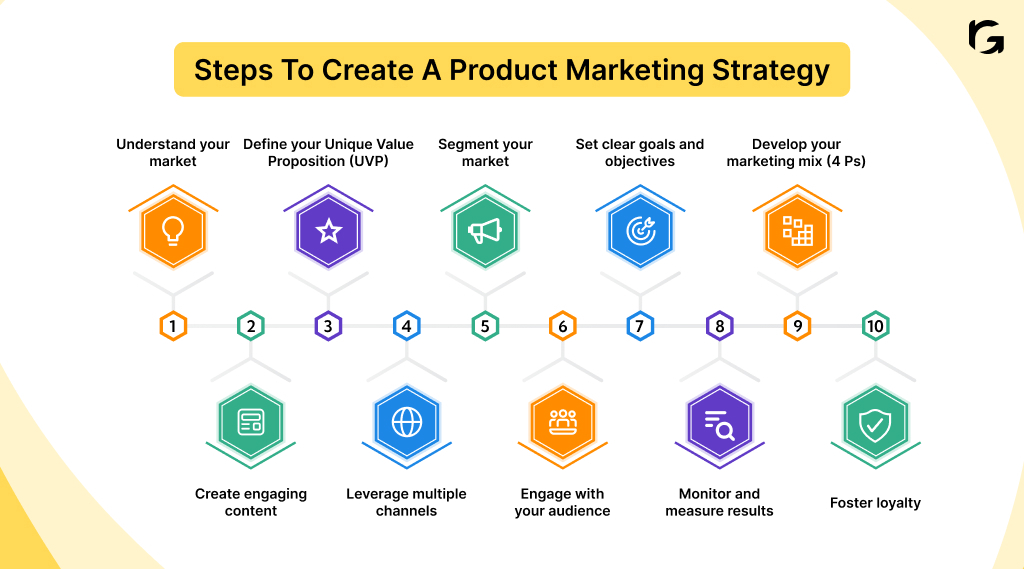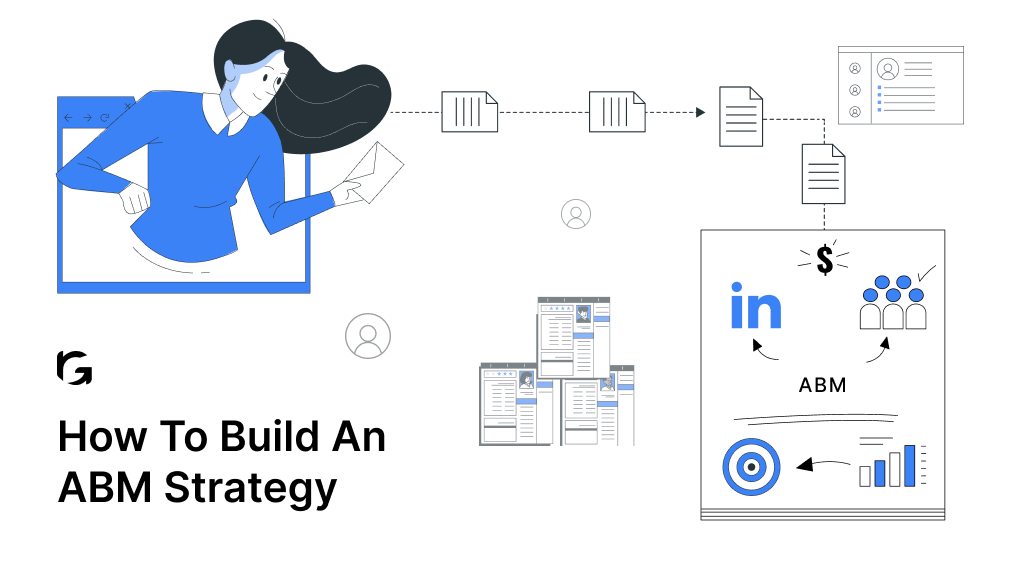Introduction
Have you ever felt lost trying to market your product in today’s market dynamics? You’re not alone. Many businesses struggle with identifying the right strategies to capture their audience’s attention and drive sales. This guide simplifies the process.
We will walk you through essential steps and frameworks to build a product marketing strategy that resonates with your customers, ensuring you connect with them effectively and achieve your business goals.
What is a product marketing strategy?
A product marketing strategy is your roadmap to promoting and selling a product. It’s about understanding your audience, pinpointing their needs, and crafting messages highlighting your product’s benefits. Key steps include market research, goal setting, product positioning, and selecting the right marketing channels. You must also price your product competitively and create compelling promotional campaigns to boost awareness and sales.
The ultimate goal? Stand out from competitors and convince customers to choose your product. Effective product marketing ensures your product meets customer needs and achieves business goals.
Exploring frameworks for product marketing strategy
Creating an effective product marketing strategy involves using structured frameworks to guide planning and execution. Here are some critical frameworks explained along with examples:
1. SWOT analysis
SWOT stands for Strengths, Weaknesses, Opportunities, and Threats. This framework helps you understand your product’s internal strengths and weaknesses, as well as external opportunities and threats.
- Strengths: What does your product do well? What advantages does it have over competitors?
- Weaknesses: Where does your product fall short? What could be improved?
- Opportunities: What market trends can you exploit? Is there new customer needs you can meet?
- Threats: What external factors could harm your product’s success? Are there competitors or market changes to watch out for?
Example: If you’re launching a new smartphone, your strengths include advanced camera technology and battery life. Your weaknesses could be a higher price point. Opportunities include increasing demand for 5G devices, while threats could consist of aggressive pricing by competitors.
2. 4 Ps of marketing
The 4 Ps framework focuses on Product, Price, Place, and Promotion. It helps you think about every aspect of marketing your product.
- Product: What are you selling? Define its features, design, and benefits.
- Price: How much will you charge? Consider costs, competitor pricing, and perceived value.
- Place: Where will you sell the product? Online, in stores, or both?
- Promotion: How will you let customers know about your product? Advertising, social media, and sales promotions are key tools.
Example: For a new fitness app:
- Product: A subscription-based app with personalized workout plans.
- Price: The monthly fee is competitive with other fitness apps.
- Place: Available on both Android and iOS platforms.
- Promotion: Social media campaigns, influencer partnerships, and introductory discounts.
3. AIDA model
The AIDA model stands for Attention, Interest, Desire, and Action. It describes the stages a customer goes through before making a purchase.
- Attention: How do you get potential customers to notice your product?
- Interest: How do you keep them interested in learning more?
- Desire: How do you make them want your product?
- Action: How do you encourage them to take the final step and purchase?
Example: For a new online course:
- Attention: Eye-catching ads on social media.
- Interest: Free webinars to showcase course benefits.
- Desire: Testimonials and success stories from previous students.
- Action: Limited-time discount for early sign-ups.
4. STP marketing
STP stands for Segmentation, Targeting, and Positioning. This framework helps you focus your marketing efforts on the right audience.
- Segmentation: Divide the market into segments based on demographics, behavior, or needs.
- Targeting: Choose the segment(s) most likely to be interested in your product.
- Positioning: Develop a marketing message that appeals to your target segment and differentiates your product from competitors.
Example: For an organic skincare line:
- Segmentation: The market is divided by age, skin type, and interest in natural products.
- Targeting: Focus on young adults interested in eco-friendly products.
- Positioning: Market as the most natural, eco-friendly skincare solution for conscious consumers.
5. Customer journey mapping
This framework involves mapping out a customer’s journey, from becoming aware of your product to purchasing it. Understanding this journey helps you create better marketing strategies.
- Awareness: How do customers first learn about your product?
- Consideration: What factors do they consider before deciding to buy?
- Purchase: What motivates them to make the purchase finally?
- Post-Purchase: How do you ensure they remain satisfied and become repeat customers?
Example: For a meal kit delivery service:
- Awareness: Online ads and social media posts.
- Consideration: Customer reviews and comparison with other services.
- Purchase: Easy online ordering and first-time user discounts.
- Post-purchase: Follow-up emails with recipes and customer support.
Examples of product marketing strategies
| Product | Framework | Strategy Example |
| Smartphone | SWOT Analysis | Strengths: Advanced camera technology, long battery life<br>Weaknesses: Higher price point<br>Opportunities: Growing demand for 5G devices<br>Threats: Competitors with aggressive pricing |
| Fitness App | 4 Ps of Marketing | Product: Subscription-based app with personalized workouts<br>Price: Competitive monthly fee<br>Place: Available on Android and iOS<br>Promotion: Social media campaigns, influencer partnerships, introductory discounts |
| Online Course | AIDA Model | Attention: Eye-catching social media ads<br>Interest: Free webinars<br>Desire: Testimonials and success stories from students<br>Action: Limited-time discounts for early sign-ups |
| Organic Skincare | STP Marketing | Segmentation: Age, skin type, interest in natural products<br>Targeting: Young adults interested in eco-friendly products<br>Positioning: Most natural, eco-friendly skincare solution for conscious consumers |
| Meal Kit Service | Customer Journey Mapping | Awareness: Online ads and social media posts<br>Consideration: Customer reviews, comparisons<br>Purchase: Easy online ordering, first-time user discounts<br>Post-Purchase: Follow-up emails with recipes, customer support |
| Electric Car | 4 Ps of Marketing | Product: Environmentally friendly car with long range<br>Price: Competitive with other electric vehicles<br>Place: Available through dealerships and online<br>Promotion: TV commercials, test drive events, social media advertising |
| Gaming Console | AIDA Model | Attention: High-profile announcements and ads<br>Interest: Exclusive game previews, tech demos<br>Desire: Reviews from popular gamers, early access to games<br>Action: Pre-order bonuses, limited edition bundles |
| Subscription Box | Customer Journey Mapping | Awareness: Influencer unboxings and online ads<br>Consideration: Detailed product descriptions and customer reviews<br>Purchase: Easy sign-up process, special offers<br>Post-Purchase: Regular updates, loyalty rewards, customer surveys |
| Eco-friendly Cleaning Products | STP Marketing | Segmentation: Households with children, eco-conscious consumers<br>Targeting: Families and individuals who prioritize health and sustainability<br>Positioning: Safe, effective cleaning solutions for health-conscious and environmentally-aware customers |
| Streaming Service | 4 Ps of Marketing | Product: Wide variety of movies, TV shows, original content<br>Price: Subscription plans at different levels<br>Place: Available on multiple devices (TV, mobile, PC)<br>Promotion: Free trials, partnerships with device manufacturers |
Steps to create a product marketing strategy that captures and creates demand
Creating a product marketing strategy that captures and creates demand involves well-planned steps.

- Understand your market
- Define your Unique Value Proposition (UVP)
- Segment your market
- Set clear goals and objectives
- Develop your marketing mix (4 Ps)
- Create engaging content
- Leverage multiple channels
- Engage with your audience
- Monitor and measure results
- Foster loyalty
1. Understand your market
- Research your audience: Start by understanding your target customers. Identify their demographics, interests, needs, and pain points. Tools like surveys, focus groups, and market research reports can help you gather this information.
- Analyze competitors: Look at your competitors. Understand what they offer, their strengths, and weaknesses. This will help you identify opportunities and gaps in the market.
2. Define your Unique Value Proposition (UVP)
- Identify your strengths: Determine what makes your product unique. This could be a specific feature, quality, or benefit that differentiates it from competitors.
- Communicate clearly: Craft a clear and compelling message that conveys your UVP. Make sure it’s easy for your target audience to understand and remember.
3. Segment your market
- Divide your audience: Segment your audience into groups based on age, location, behavior, and preferences. This allows you to tailor your marketing efforts to specific needs and interests.
- Prioritize segments: Focus on the segments most likely to convert into customers. These are your primary target markets.
4. Set clear goals and objectives
- Define Success: Set specific, measurable goals for your marketing strategy. These include increasing brand awareness, boosting sales, or expanding market share.
- Create a Timeline: Establish a timeline for achieving these goals. Having deadlines helps keep your team focused and on track.
5. Develop your marketing mix (4 Ps)
- Product: Ensure your product meets the needs of your target audience. Highlight features that appeal to them.
- Price: Set a competitive price that reflects the value of your product. Consider factors like production costs, competitor pricing, and perceived value.
- Place: Decide where your product will be available. This could be online, in physical stores, or both. Choose distribution channels that are convenient for your customers.
- Promotion: Plan how you will promote your product. Use a mix of advertising, social media, email marketing, and PR to reach your audience. Tailor your messages to different segments to maximize impact.
6. Create engaging content
- Develop a content strategy: Create content that educates, entertains, and engages your audience. This can include blog posts, videos, infographics, and social media updates.
- Highlight benefits: Focus on how your product solves problems and meets needs. Use customer testimonials and case studies to build credibility.
7. Leverage multiple channels
- Use various platforms: Promote your product across social media, email, search engines, and offline methods like events or print ads.
- Consistency is key: Ensure your messaging is consistent across all platforms. This helps build a strong, recognizable brand.
8. Engage with your audience
- Build relationships: Interact with your audience on social media, respond to comments, and engage in conversations. Show that you value their opinions and feedback.
- Offer support: Provide excellent customer service and ensure customers can easily get help and support when needed.
9. Monitor and measure results
- Track performance: Use analytics tools to track the performance of your marketing efforts. Monitor metrics like website traffic, conversion rates, and sales.
- Adjust strategies: Based on your findings, adjust your strategies to improve results. Continuously test different approaches to see what works best.
10. Foster loyalty
- Reward customers: Implement loyalty programs or offer discounts to repeat customers. Show appreciation for their continued support.
- Keep engaging: Stay in touch with customers through newsletters, updates, and personalized offers. This keeps your brand top-of-mind and encourages repeat business.
Exploring various product marketing strategy templates
| Template Name | Description | Key Components |
| SWOT Analysis | SWOT stands for Strengths, Weaknesses, Opportunities, and Threats. This template helps identify the product’s internal strengths and weaknesses and external opportunities and threats in the market. | – Strengths: Identify what the product does well. – Weaknesses: Identify areas where the product can improve. – Opportunities: Identify trends or market opportunities that the product can leverage. – Threats: Identify potential challenges or obstacles in the market. |
| 4 Ps of Marketing | The 4 Ps stand for Product, Price, Place, and Promotion. This template covers all aspects of marketing strategy, including product features, pricing strategy, distribution channels, and promotional activities. | – Product: Features, design, and benefits of the product. – Price: Pricing strategy based on costs and market demand. – Place: Distribution channels where the product will be available. – Promotion: Marketing and advertising strategies to promote the product. |
| AIDA Model | AIDA stands for Attention, Interest, Desire, and Action. This template outlines the stages a customer goes through before making a purchase, helping to craft marketing messages that guide customers through these stages. | – Attention: Grab the customer’s attention with compelling messaging or visuals. – Interest: Keep the customer engaged by highlighting product benefits or solving a problem. – Desire: Create desire for the product by showcasing its value or uniqueness. – Action: Encourage the customer to take action, such as making a purchase or signing up. |
| STP Marketing | STP stands for Segmentation, Targeting, and Positioning. This template involves dividing the market into segments, selecting the most attractive segments, and effectively positioning the product to meet those segments’ needs. | – Segmentation: Divide the market based on demographics, behavior, or needs. – Targeting: Choose the segments with the highest potential for sales. – Positioning: Develop a unique value proposition that resonates with the chosen segments. |
| Customer Journey Mapping | Customer journey mapping involves understanding customers’ steps, from becoming aware of the product to making a purchase decision. This template helps identify touchpoints and opportunities to engage customers throughout their journey. | – Awareness: How customers become aware of the product. – Consideration: What factors influence their decision-making process? – Purchase: The point at which customers decide to buy. – Post-Purchase: How customers feel after purchasing and their experience with the product. |
| 5 Cs Framework | The 5 Cs are Company, Collaborators, Customers, Competitors, and Climate. This template helps analyze various internal and external factors that can impact the product’s success in the market. | – Company: Analyze the company’s internal strengths and weaknesses. – Collaborators: Evaluate relationships with suppliers, distributors, and partners. – Customers: Understand the needs and preferences of target customers. – Competitors: Assess competitor strengths and weaknesses. – Climate: Consider external factors such as economic conditions, regulatory environment, and market trends. |
| Marketing Funnel | The marketing funnel template maps out the stages of the customer journey, from awareness to conversion, and helps tailor marketing strategies for each stage. | – Awareness: Attracting the attention of potential customers. – Interest: Generating interest in the product and its benefits. – Consideration: Encouraging customers to consider purchasing the product. – Conversion: Converting leads into paying customers. – Retention: Keeping customers engaged and satisfied to encourage repeat purchases. |
| Brand Positioning Canvas | This template helps define and visualize the unique position of the product in the market compared to competitors, considering factors such as brand attributes, customer perceptions, and competitive advantages. | – Purpose: Define the purpose and mission of the brand. – Values: Identify the core values and beliefs that the brand represents. – Target Audience: Describe the ideal customer persona for the brand. – Brand Promise: Communicate the unique value proposition and benefits offered. – Competitive Advantage: Highlight what sets the brand apart from competitors. |
| Template Name | Description | Key Components |
| SWOT Analysis | SWOT stands for Strengths, Weaknesses, Opportunities, and Threats. This template helps identify the product’s internal strengths and weaknesses and external opportunities and threats in the market. | – Strengths: Identify what the product does well. – Weaknesses: Identify areas where the product can improve. – Opportunities: Identify trends or market opportunities that the product can leverage. – Threats: Identify potential challenges or obstacles in the market. |
The bottom line
A well-crafted product marketing strategy is essential for effectively promoting and selling a product. Businesses can capture and create demand by understanding the market, defining a unique value proposition, and leveraging key frameworks. With clear goals, engaging content, and a customer-centric approach, companies can drive growth and achieve their objectives. Consider implementing a comprehensive Product Marketing Strategy tailored to your business needs for accelerated revenue growth.
Partner with RevvGrowth to grow your B2B SaaS business. We help you craft tailored marketing strategies, monitor key performance indicators, and stay ahead of the competition while boosting your revenue.
Ready to transform your B2B business growth? Connect with our team of experts today!
FAQs
1. What are the key components of a successful product marketing strategy?
– Key components include market research, competitive analysis, positioning, messaging, product launch planning, and sales enablement.
2. How do I conduct effective market research for my product?
– Use surveys, interviews, focus groups, and data analysis to understand market trends and customer needs.
3. What steps are involved in planning a product launch?
– Steps include setting launch goals, creating a timeline, developing marketing materials, and coordinating with sales teams.
4. How can sales enablement support product marketing?
– Sales enablement provides tools, resources, and training to help sales teams effectively sell the product.
5. What methods can be used for competitive analysis?
– Methods include SWOT analysis, benchmarking, competitor reviews, and monitoring their marketing strategies.


